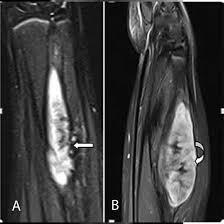Fill out form to enquire now
MRI For Right Forearm
Medintu has collaborated with the best pathology laboratories that are NABL and NABH certified and follow ISO safety guidelines to provide the best MRI For Right Forearm at an affordable price for needy individuals.
Magnetic Resonance Imaging (MRI) is a powerful and non-invasive diagnostic tool used to visualize the internal structures of the body in great detail. An MRI of the right forearm specifically focuses on capturing high-resolution images of the bones, muscles, tendons, ligaments, nerves, and other soft tissues within the forearm. Whether you’re dealing with an injury, chronic pain, or a medical condition affecting the forearm, an MRI can provide invaluable insights to help guide diagnosis and treatment. This imaging technique is widely used for its ability to detect a range of conditions that might not be visible on X-rays or other imaging tests. From fractures and tears to inflammation and nerve compression, an MRI can provide a comprehensive view of what’s happening inside your forearm, even at the microscopic level. It’s particularly beneficial for identifying issues with soft tissues, which X-rays cannot assess effectively.
To schedule an appointment for an MRI For Right Forearm, simply contact Medintu or call our customer care at +919100907036 or +919100907622 for more details and queries.
Common Reasons for an MRI of the Right Forearm
An MRI of the right forearm is often recommended when there are symptoms or conditions affecting the arm that require detailed imaging to diagnose accurately. Below are some of the most common reasons for having an MRI of the right forearm:
- Muscle Strains or Tears
Muscle injuries, including strains and tears, are common in the forearm, especially for those involved in repetitive motions or activities that stress the muscles. An MRI can help determine the extent of muscle damage, whether there is a partial or full tear, and assist in planning an appropriate treatment plan.
- Tendonitis or Tendon Tears
Tendonitis (inflammation of a tendon) is common in the forearm, often caused by repetitive motions or overuse. Conditions like tennis elbow (lateral epicondylitis) or golfer’s elbow (medial epicondylitis) can result in pain, tenderness, and limited movement in the forearm.
- Ligament Injuries or Sprains
Ligaments in the forearm help stabilize the wrist and elbow joints. Sprains, tears, or damage to ligaments (such as the ulnar collateral ligament) can occur due to trauma or overuse. MRI can help assess the extent of ligament injuries and whether surgical intervention may be necessary.
- Fractures or Bone Injuries
Fractures of the forearm bones (radius or ulna) may not always be visible on X-rays, especially if they are hairline fractures or involve the joint. An MRI can provide detailed images of the bone structure and any associated bone bruises or stress fractures, which are often difficult to detect with other imaging methods.
- Nerve Compression or Entrapment
Conditions like carpal tunnel syndrome, cubital tunnel syndrome, or radial nerve entrapment can cause symptoms like numbness, tingling, weakness, or pain in the forearm and hand.
- Arthritis or Joint Degeneration
Osteoarthritis or rheumatoid arthritis can affect the forearm’s joints, including the wrist, elbow, and the radioulnar joint. Symptoms include joint pain, swelling, stiffness, and limited range of motion.
How MRI for the Right Forearm Works?
An MRI (Magnetic Resonance Imaging) scan of the right forearm uses powerful magnets, radio waves, and advanced computer technology to produce detailed images of the internal structures of the forearm, including bones, muscles, tendons, ligaments, nerves, and blood vessels. Unlike X-rays or CT scans, which primarily focus on bones, MRI provides superior visualization of soft tissues—making it especially useful for diagnosing conditions related to muscles, joints, and nerves.
Here’s an overview of how the MRI process works when used to assess the right forearm:
- Magnetic Field and Radio Waves
Magnetic Field: The MRI machine creates a strong magnetic field (usually 1.5 to 3 Tesla) that aligns the hydrogen atoms in your body. Since your body is largely made up of water, which contains hydrogen atoms, MRI is particularly effective for visualizing soft tissues.
Radio Waves: Once the hydrogen atoms are aligned by the magnetic field, the MRI machine sends out radiofrequency pulses that momentarily disturb this alignment. When the radio waves are turned off, the hydrogen atoms return to their normal position, releasing energy in the process.
- Imaging the Right Forearm
Soft Tissue Imaging: MRI excels at imaging soft tissues (muscles, tendons, ligaments, nerves, and blood vessels) in great detail. In the right forearm, this allows doctors to diagnose conditions like muscle strains, tendonitis, ligament sprains, or nerve compression with clarity.
Bone Imaging: While MRI is better known for imaging soft tissues, it can also provide detailed images of bones. This is particularly useful for detecting bone fractures, stress fractures, bone bruises, or degenerative changes in the bones of the forearm, such as those caused by arthritis.
- The Role of Contrast Agents (If Applicable)
In some cases, a contrast agent (typically gadolinium) may be injected into a vein, usually in the arm. The contrast agent enhances the visibility of certain structures or abnormalities by highlighting areas with increased blood flow or inflammation, such as:
Inflammation in tendons or joints
Abnormal growths or tumors
Vascular structures (blood vessels)
- The MRI Procedure for the Right Forearm
Preparation: Before the MRI, you’ll be asked to remove any metallic objects (such as jewelry, watches, or clothing with metal fasteners) to prevent interference with the magnetic field.
Positioning: Once you’re comfortably positioned on the MRI table, your right arm will likely be positioned in a way that allows the MRI machine to capture clear images of the forearm.
Inside the MRI Machine: During the MRI scan, you will be moved into the machine’s cylindrical magnet. The MRI machine is typically open at both ends, but it may feel somewhat confining, especially if you’re nervous about small spaces.
The MRI Procedure for the Right Forearm
The MRI procedure for the right forearm is a straightforward, non-invasive diagnostic test that helps doctors visualize the soft tissues (muscles, tendons, ligaments, nerves) and bones in the forearm to diagnose a variety of conditions. Below is a step-by-step guide to what you can expect during the MRI process for the right forearm.
- Preparing for Your MRI
Before the Procedure:
Remove metal objects: Since MRI uses a powerful magnetic field, you’ll be asked to remove all metallic items such as jewelry, watches, piercings, hairpins, or belts. Metal can interfere with the magnetic field and affect the quality of the images.
Wear comfortable clothing: It’s recommended to wear loose, comfortable clothing without metal fasteners (such as zippers or buttons). If your clothes contain metal, you may be asked to change into a hospital gown for the procedure.
Health questionnaire: You’ll be asked about your medical history, any metal implants (like pacemakers or joint replacements), or allergies, especially if contrast dye is to be used.
- Positioning for the MRI Scan
Getting Comfortable:
Once you’re inside the MRI room, you’ll lie down on the MRI table. The technologist will position your right arm to ensure the MRI can capture clear, detailed images of your forearm.
You may be asked to extend or slightly bend your arm depending on which part of the forearm is being imaged.
- The MRI Scan
Entering the MRI Machine:
After you’re positioned, the MRI table will move you into the MRI machine. The machine is a large, tube-like structure with a powerful magnetic field that will surround your body.
While inside the machine, your right forearm will be within the magnetic field, allowing the MRI to capture detailed images. If you experience any discomfort or anxiety, don’t hesitate to let the technologist know.
The technologist will be able to communicate with you throughout the procedure, either through an intercom or by speaking to you through a headset. If you need to move or feel uncomfortable, you can alert them, and they will stop the scan if necessary.
Benefits of MRI for the Right Forearm
An MRI (Magnetic Resonance Imaging) scan of the right forearm is a powerful diagnostic tool that offers a wide range of benefits for both patients and healthcare providers. Here are some of the key benefits of undergoing an MRI for the right forearm:
- Non-Invasive and Painless
No Surgery or Needles (Except for Contrast Injection):
An MRI is a non-invasive procedure, meaning it does not involve surgery, cuts, or incisions. There are no risks associated with internal procedures, and it does not require any needles (except in cases where a contrast dye is used).
- Highly Detailed Soft Tissue Imaging
Superior Soft Tissue Visualization:
MRI is particularly effective in capturing detailed images of soft tissues, including muscles, tendons, ligaments, nerves, and blood vessels. This makes it an invaluable tool for diagnosing conditions like tendonitis, ligament tears, muscle strains, or nerve compression in the forearm.
- Accurate Diagnosis of Bone Injuries and Conditions
Bone Fractures and Stress Injuries:
While X-rays are often used to detect bone fractures, MRI can reveal small fractures or stress fractures in the bones of the forearm that may not be visible on standard X-rays. MRI can also provide information about bone bruises or bone marrow abnormalities.
- Detection of Inflammatory Conditions
Inflammation and Infection:
MRI can help diagnose inflammatory conditions such as tendonitis, bursitis, or rheumatoid arthritis that cause swelling and pain in the forearm. It can also detect soft tissue infections or abscesses that might not be visible on X-rays.
- Detailed Nerve Imaging
Nerve Compression and Entrapment:
MRI is highly effective in diagnosing nerve-related conditions such as carpal tunnel syndrome, cubital tunnel syndrome, or radial nerve entrapment. It can reveal if a nerve is being compressed by surrounding tissues, inflammation, or structural abnormalities, such as herniated discs or bone spurs.
- Test Type: MRI For Right Forearm
- Preparation:
- Wear a loose-fitting cloth
- Fasting not required
- Carry Your ID Proof
- Prescription is mandatory for patients with a doctor’s sign, stamp, with DMC/HMC number; as per PC-PNDT Act
- Reports Time: With in 4-6 hours
- Test Price: Rs.4500
How can I book an appointment for an MRI For Right Forearm through Medintu?
To schedule an appointment for an MRI For Right Forearm, simply contact Medintu or call our customer care at +919100907036 or +919100907622 for more details and queries.
What is an MRI of the Right Forearm?
An MRI of the right forearm is a medical imaging technique used to create detailed pictures of the bones, muscles, tendons, ligaments, nerves, and other soft tissues in your forearm. It uses magnetic fields and radio waves to generate high-resolution images without the use of radiation. MRI is often used to diagnose injuries, inflammation, infections, or other conditions affecting the forearm.
Why do I need an MRI of my Right Forearm?
You may need an MRI of the right forearm if you are experiencing:
- Pain, swelling, or weakness in the forearm.
- Suspected fractures, tears, or other bone injuries.
- Tendonitis, ligament sprains, or muscle strains.
- Nerve compression or issues like carpal tunnel syndrome.
- Infections, tumors, or abnormal growths.
- Chronic conditions like arthritis or repetitive strain injuries.
- Your doctor will recommend an MRI based on your symptoms and medical history.
Is MRI of the Right Forearm Safe?
Yes, MRI is a safe and non-invasive procedure. It uses a magnetic field and radio waves to create images, so there is no radiation involved. However, MRI may not be suitable for people with certain implants (e.g., pacemakers, metal implants) or other contraindications, so it’s important to inform the MRI technician about your medical history.
What should I wear for my MRI of the Right Forearm?
For your MRI of the right forearm, wear comfortable, loose-fitting clothes without metal fasteners (such as zippers or buttons). You may be asked to change into a hospital gown if your clothing has metal or is not suitable for the MRI machine.
Will I need to remove metal objects before the MRI?
Yes, you will need to remove all metal items, including:
- Jewelry (earrings, necklaces, rings, bracelets).
- Watches and hairpins.
- Piercings (if possible).
- Clothing with metal fasteners (zippers, buttons, etc.).
- This is because the MRI machine uses a strong magnetic field, and metal can interfere with the imaging process or cause injury.
Will I need an IV or contrast dye for the MRI?
In some cases, contrast dye (gadolinium) is injected into your vein through an IV to enhance the MRI images. Contrast is typically used if your doctor needs to get a clearer view of certain tissues or areas of the forearm, such as inflammation, tumors, or blood vessels.
You will be informed beforehand if contrast is required. If you have a history of allergic reactions to contrast agents, be sure to tell the MRI technician or radiologist.
Is the MRI procedure painful?
No, the MRI procedure is generally painless. However, you may experience some discomfort from lying still on the MRI table for a period of time (typically 20 to 45 minutes). If you are having contrast dye injected, you may feel a brief cool sensation or a slight pinch at the IV site.
How long does the MRI take?
An MRI of the right forearm typically takes 20 to 45 minutes, depending on the complexity of the scan and whether contrast dye is used. You may need to remain still during this time to ensure high-quality images.
Why Choose Medintu for MRI For Right Forearm?
Medintu is an online medical consultant that provides home-based medical services not only in your area but also in most cities in India, including Hyderabad, Chennai, Mumbai, Kolkata, and more. We have collaborated with diagnostic centers that have the best machines and equipment to ensure you get accurate results. Medintu provides 24-hour customer service for booking the appointment of the services and guides you with instructions. Medintu also provides the best diagnostic centers at low prices. Once you receive your test results, you can easily book an appointment with our network of experienced doctors for consultation. To schedule an appointment for an MRI For Right Forearm, simply contact Medintu or call our customer care at +919100907036 or +919100907622 for more details and queries.





